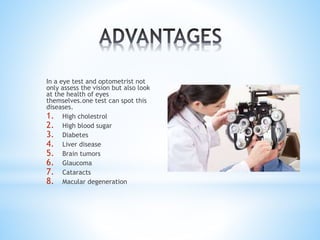The Role of Advanced Diagnostic Equipment in Identifying Eye Disorders
In the world of ophthalmology, the application of advanced diagnostic tools has actually changed the early recognition and management of different eye disorders. As the demand for specific and prompt diagnoses proceeds to expand, the assimilation of advanced devices like optical coherence tomography and aesthetic area screening has become vital in the world of eye care.
Importance of Very Early Diagnosis
Very early diagnosis plays a critical role in the reliable administration and therapy of eye disorders. Prompt recognition of eye problems is important as it permits prompt treatment, possibly avoiding more progression of the condition and minimizing long-lasting complications. By spotting eye problems at a beginning, medical care service providers can supply proper therapy plans tailored to the specific problem, eventually bring about much better results for people. In addition, very early diagnosis enables patients to gain access to required assistance solutions and sources sooner, improving their general high quality of life.

Technology for Spotting Glaucoma
Cutting-edge analysis modern technologies play an important role in the very early detection and monitoring of glaucoma, a leading cause of irreversible blindness worldwide. One more advanced device is aesthetic area screening, which maps the sensitivity of a person's visual field, assisting to find any type of areas of vision loss attribute of glaucoma. These innovative analysis tools allow ophthalmologists to identify glaucoma in its early stages, enabling for timely intervention and much better monitoring of the illness to prevent vision loss.
Function of Optical Coherence Tomography

OCT's capability to evaluate retinal nerve fiber layer thickness permits exact and unbiased measurements, helping in the very early detection of try this site glaucoma also prior to aesthetic field flaws end up being apparent. Additionally, OCT innovation allows longitudinal tracking of architectural changes over time, helping with customized treatment strategies and timely interventions to help preserve individuals' vision. The non-invasive nature of OCT imaging likewise makes it a recommended option for keeping an eye on glaucoma progression, as it can be repeated consistently without causing pain to the client. Overall, OCT plays a vital role in improving the analysis precision and management of glaucoma, eventually adding to far better outcomes for individuals in danger of vision loss.
Enhancing Diagnosis With Visual Field Testing
An important element in extensive sensory examinations, aesthetic field testing plays an essential duty in boosting the analysis procedure for different eye conditions. By evaluating the complete degree of an individual's aesthetic area, this examination supplies important info regarding the practical stability of the entire visual pathway, from the retina to the aesthetic cortex.
Aesthetic area testing is especially useful in the medical diagnosis and administration of problems such as glaucoma, optic nerve conditions, and different neurological illness that can impact vision. Through quantitative dimensions of outer and central vision, clinicians can find refined modifications that may indicate the visibility or development of these conditions, even before recognizable signs and symptoms happen.
Additionally, visual Read Full Article area testing allows for the surveillance of therapy effectiveness, helping ophthalmologists tailor therapeutic treatments to specific patients. eyecare near me. By tracking adjustments in aesthetic area efficiency in time, doctor can make enlightened choices regarding changing medications, recommending surgical treatments, or applying various other suitable steps to protect or enhance an individual's visual function
Managing Macular Deterioration

Conclusion
Finally, advanced diagnostic tools play a vital duty in recognizing eye problems beforehand. Technologies such as Optical Coherence Tomography and visual field testing have significantly enhanced the precision and performance of detecting problems like glaucoma and macular deterioration. Early discovery permits prompt treatment and monitoring of these problems, inevitably bring about far better end results for patients. It is essential for healthcare professionals to remain updated on these developments to offer the very best possible take care of have a peek at this website their individuals. eyecare near me.
Comments on “Comprehensive Retina Service Near Me: Advanced Eye Healthcare”